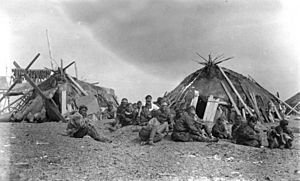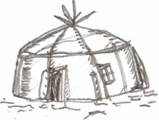Yaranga facts for kids

A Yaranga is a special type of tent that some nomadic groups in Northern Russia use as their home. These groups include the Chukchi and Siberian Yupik people.
A Yaranga is usually shaped like a cone or a dome. It is built using a light wooden frame and covered with reindeer skins or strong canvas sewn together.
The word yaranga comes from the Chukchi language, where jaraŋə means "house." Sometimes, in Russian, people might use the words chum, yurt, and yaranga to mean similar types of traditional homes.
Contents
What is a Yaranga?
A Yaranga is a mobile home, meaning it can be moved from one place to another. This is very useful for nomadic people who travel often to find food or better living conditions.
These tents are designed to be strong and warm, protecting people from the harsh weather in the Arctic regions. They are an important part of the culture and history of the people who live in them.
Building a Yaranga
Building a Yaranga starts with a frame made from lightweight wood. This frame is strong enough to hold the heavy coverings but light enough to be taken apart and moved.
The frame is then covered with many reindeer skins. These skins are carefully sewn together to create a thick, warm, and waterproof covering. A medium-sized Yaranga might need about 50 reindeer skins!
Staying Warm Inside
Even with many reindeer skins, a large Yaranga can be hard to heat completely. To solve this, people build a smaller, warmer cabin inside the main tent. This inner cabin is called a polog.
The polog is like a cozy room within the larger Yaranga. It is kept warm and comfortable, providing a snug place for sleeping and daily life, especially during cold winters.
Yaranga Homes of Different Peoples
The design and use of the Yaranga can vary slightly among different groups of people.
Chukchi Yaranga
The Chauchu Chukchi people, who are nomadic reindeer herders, use the Yaranga as their main home. Their Yaranga is built with a light wooden frame and covered with sewn reindeer skins.
The polog inside their Yaranga helps them stay warm. It creates a smaller, heated space where families can live comfortably, even when the outside of the main tent is very cold.
Siberian Yupik and Anqallyt Chukchi Homes
The Siberian Yupik people, especially the Chaplino Eskimos (also called Ungazigmit), had a round, dome-shaped building for winter. They also called it a "yaranga," but in their own language, it was called a mengteghaq.
Their mengteghaq was built with a framework of posts and covered with strong tarpaulins. The base of the yaranga was often surrounded by sod or wooden planks for extra insulation.
Inside the Yupik Yaranga
Just like the Chukchi, the Chaplino Eskimos had a smaller cabin inside their winter home for sleeping and living. This inner room was called an aaghra. It was separated from the cooler outer parts of the yaranga by reindeer skins and grass, supported by a cage-like frame.
The larger outer room of the yaranga, in front of the inner cabin, was used for household chores. During winter storms or at night, dogs would also stay in this outer room. This area, used for practical purposes, was called a natyk.
Other Yupik Buildings
The Chaplino Eskimos also had other types of buildings. An aawxtaq was a more modern type of home, and a pelyuk was a lighter structure used during the summer months.
|


